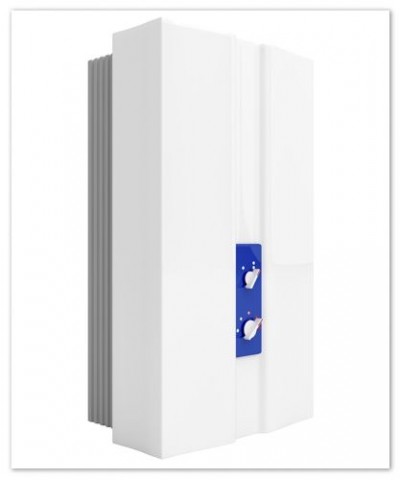How tankless water heaters work
In conventional water heating systems, water is heated and then stored in a tank. This may continue for a long time, and the water may remain unused. Thus, a lot of energy is wasted when you do not use hot water (standby heat loss).
Tankless water heaters do not have storage tanks, and water that passes through such devices is heated directly by a gas burner or an electric element. When needed, these heaters can provide hot water non-stop. This makes them more energy-efficient compared to tank heaters. If you have a tankless heater, you won’t have to wait until the tank is filled up. As water passes through the system, it is heated almost instantly. The incoming water activates a heat exchanger that transfers heat received from a gas burner or electric coils. Therefore, it allows you to get hot water on demand without a significant standby heat loss.
Types of tankless heaters
There are two main types of tankless water heaters: point-of-use and whole-house. Point-of-use heaters are compact in size and are usually intended for one outlet: a sink, bathroom shower, etc. They can be placed close to the outlet and therefore have no lag time, which reduces water loss. Most point-of-use heaters are electricity-powered.
Whole-house heaters provide hot water for several water outlets and are installed in big households. Most such heaters use gas burners. Because they have to heat a larger amount of water, the lag time can be significant. This leads to a significant water loss and may throw their energy-efficiency into question.
Pros
- Because tankless heaters provide water when needed only, you will never run out of hot water. Absence of standby heat loss makes a tankless heater more energy-efficient, and it can save you up to 20% of your water heating bill.
- Compact point-of-use heaters are also space-efficient, because they can be installed in sink cabinets.
- Electric heaters do not take up oxygen or emit greenhouse gases.
- There is no danger of the flooding of your living space.
- Tankless heaters have a life span of 15-20 years compared to 10 years for tank water heaters.
Cons
- Tankless water heaters are about three times more expensive than tank water heaters.
- Whole-house heaters require a larger amount of gas and expensive venting systems.
- Electric heaters consume a lot of electricity and require expensive circuit systems.
- Gas heaters produce a green-house effect and take up oxygen.
If you are at a loss as to whether or not you should go tankless, there are two things to consider: costs and payback period. As follows from the above, switching to a tankless heater will require a greater investment, but it will pay you back in future. Make sure you can handle installation, as well as electricity/gas line/venting system upgrades. Put all these factors together and make a decision!
Alpine Air Heating and Cooling offers quality tankless water heaters to the customers in Milton, Georgetown, Brampton, Oakville, Acton, Burlington, Mississauga and surrounding communities. You can call us anytime at 905 877-2877 or 416 898-2665 to learn more about Alpine Air Heating & Cooling and the services we provide.


